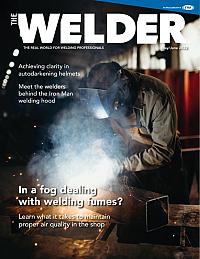Owner, Brown Dog Welding
- FMA
- The Fabricator
- FABTECH
- Canadian Metalworking
Categories
- Additive Manufacturing
- Aluminum Welding
- Arc Welding
- Assembly and Joining
- Automation and Robotics
- Bending and Forming
- Consumables
- Cutting and Weld Prep
- Electric Vehicles
- En Español
- Finishing
- Hydroforming
- Laser Cutting
- Laser Welding
- Machining
- Manufacturing Software
- Materials Handling
- Metals/Materials
- Oxyfuel Cutting
- Plasma Cutting
- Power Tools
- Punching and Other Holemaking
- Roll Forming
- Safety
- Sawing
- Shearing
- Shop Management
- Testing and Measuring
- Tube and Pipe Fabrication
- Tube and Pipe Production
- Waterjet Cutting
Industry Directory
Webcasts
Podcasts
FAB 40
Advertise
Subscribe
Account Login
Search
Playing With Fire: A challenge to metal fabrication's skills gap conversation
Revisiting the need to address the true labor problems facing the manufacturing sector
- By Josh Welton
- Updated August 29, 2023
- June 8, 2022
- Article
- Shop Management
“We are all faced with a series of great opportunities brilliantly disguised as impossible situations.” - Charles R. Swindoll
Beating a dead horse. Pushing a boulder up a never-ending incline. Dragging water across land with a rake. Futility. Frustration. Doubt creeps in. Is this battle worth the trouble? Is it even winnable? Heck, what would “winning” even look like? Or is this merely a Sisyphean task, and we’re stuck toiling in an infinite loop, a struggle without payoff, without end? I don’t want to spend this much energy on a pointless undertaking. But, deep down, I believe the fight is a worthwhile cause. Zeus has not saddled me with punishment—instead, the welding industry has revealed to us a long-standing challenge. And in turn, we, the welders, need to understand the stakes and confront the antagonists in kind. On the other hand, if you read this piece and realize that you are said antagonist, let’s talk. Ignorance has long failed to justify your position.
My love affair with factory life started in 1996—the summer between high school and college—and has been constant ever since. There were classes and a few other second and third jobs. Still, even as a teen working on a paint line at Steelcase in Grand Rapids, Mich., I thought, “Man, this beats sitting in a lecture regarding ontological arguments for the existence of God.” Actually, those classes were cool. I mostly didn’t like studying physics, math, or anything else. And I hated the writing assignments (imagine that).
In contrast, I loved the grit and grind of blue-collar work in factories and in the field. By the time I struck my first arc as a millwright apprentice in 2001, a liberal arts degree was of no interest to me. I wanted to work and build a career with my hands. Thanks to Chrysler and the UAW, I had both, and eventually I started my own side business, Brown Dog Welding.
In 2010 after taking a pre-bankruptcy buyout from Chrysler, I became a fabricator/driver/mechanic for General Dynamics Land Systems, where I currently work. This job has allowed me to travel the country and the world, to work on top-secret military projects, to even travel to Iraq to repair battle-damaged Abrams tanks. And I’ve been a contributing writer to TheFabricator.com and to this fine magazine since 2014.
This CliffsNotes biography merely says that I’ve been around the trades for a minute. I’ve seen the good, the bad, and almost everything in between. There has been a lot of change, some evolution, but not enough.
One lie above them all has stood the test of time, as if written in stone. It is, of course, the so-called “skills gap.” The idea is that the experienced and skilled workforce is retiring, that there aren’t enough middle-aged folks to fill in those potential vacancies, and that nobody from the younger generation wants to work. It was as nonsensical 26 years ago as it is now.
It was around 20 years back when Steelcase caused its own skills gap, if we go by the industry's bullshit definition. They went from being private and family-owned for generations to publicly traded under the helm of Jim Hackett, who more recently was hired by Ford and retired abruptly after three years—a terrible CEO for the automaker.
There had never been a union at Steelcase, so there was no recourse for what happened next. The company outsourced most of its manufacturing to cheap, overseas factories. They laid off a considerable chunk of their workforce from the bottom up—folks with 20 years’ seniority and down got broomed out. The remaining workers took massive pay cuts while many others retired early. This devasted the local economies in Kentwood and Grand Rapids. Once proud furniture-makers scrambled to find work delivering pizzas.
In the five years I spent working there, I heard repeatedly that “This is a good gig!” “The average age of a factory worker is 55!” “There are opportunities for your generation!”
This wasn’t only a Steelcase problem; this was an American problem. Companies from the Atlantic to the Pacific were closing down/downsizing domestic production to chase short-sighted dreams of cheap labor in lands where OSHA, pensions, and the value of human life were frolicking in fields with unicorns.
If industry advocates want to define the skills gap as not having enough qualified workers to fill the jobs—as most seem to want to claim—then they caused the problem themselves by literally taking the jobs away. Yet somehow, the workforce gets the blame. Lazy, looking for handouts, unwilling to learn, blah blah blah. Oh, but you have jobs now? And you promise this time you won’t go all Lucy and pull the football away once I’ve invested years of blood, sweat, and tears into my career? Forgive this Charlie Brown for not believing you.
It has been 26 years since I first stepped foot in a factory and heard about this freaking skills gap, and I’m still hearing about this freaking skills gap, but now its BS is rivaled only by how widely accepted it is. These lies continue to hurt the worker. Some organizations are profiting from this idea that skilled welders are in abnormally high demand and will continue to be going forward seem unconcerned with facts. The skills gap isn’t real, hasn’t been the case in decades, and isn’t about to change.
I’m not going to refute their claims with stats from the Bureau of Labor Statistics or definitions and in-depth studies from think tanks like the Economic Policy Institute. I’ve done it previously, both in this column and elsewhere, and nothing changes. The powers that be do not care about truth or transparency. They just want us to fill their classrooms; buy their CWI study guides, tests, and memberships; and fill their jobs as cheaply as possible. They do not advocate for you, the welder.
So, I offer this challenge: If you remain convinced that the skills gap is real and that it is not a wage gap issue, get in touch and we’ll chat. I and others are curious how a story without basis in reality has maintained its position as your party line for decades.
William Butler Yeats once wrote about a particular place and time in history: “The best lack all conviction, while the worst are full of passionate intensity.” Here is to hoping that’s not true in this battle, place, and time.
About the Author

About the Publication
subscribe now

The Welder, formerly known as Practical Welding Today, is a showcase of the real people who make the products we use and work with every day. This magazine has served the welding community in North America well for more than 20 years.
start your free subscription- Stay connected from anywhere

Easily access valuable industry resources now with full access to the digital edition of The Fabricator.

Easily access valuable industry resources now with full access to the digital edition of The Welder.

Easily access valuable industry resources now with full access to the digital edition of The Tube and Pipe Journal.
- Podcasting
- Podcast:
- The Fabricator Podcast
- Published:
- 04/16/2024
- Running Time:
- 63:29
In this episode of The Fabricator Podcast, Caleb Chamberlain, co-founder and CEO of OSH Cut, discusses his company’s...
- Trending Articles
Sheffield Forgemasters makes global leap in welding technology

ESAB unveils Texas facility renovation

Engine-driven welding machines include integrated air compressors

How welders can stay safe during grinding

The impact of sine and square waves in aluminum AC welding, Part I

- Industry Events
16th Annual Safety Conference
- April 30 - May 1, 2024
- Elgin,
Pipe and Tube Conference
- May 21 - 22, 2024
- Omaha, NE
World-Class Roll Forming Workshop
- June 5 - 6, 2024
- Louisville, KY
Advanced Laser Application Workshop
- June 25 - 27, 2024
- Novi, MI



























